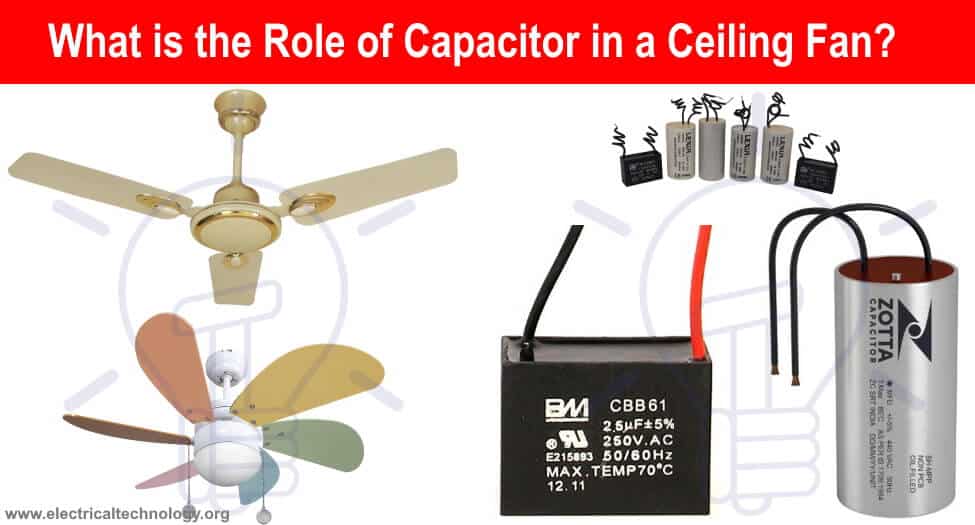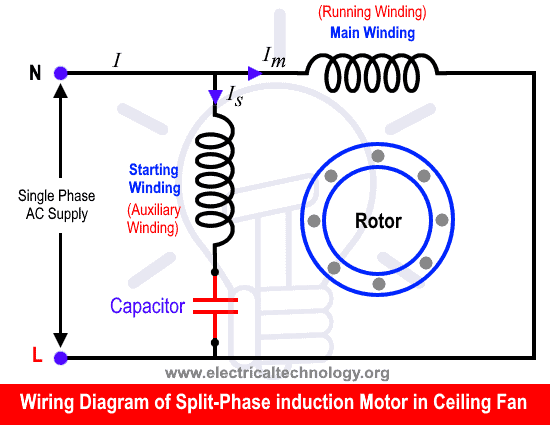The most asked question among electrical engineering interview questions about the main function of a capacitor in a ceiling fan. During the class lectures and viva examination, they mostly asked about the role of capacitor in a ceiling fan. If you are one of them seeking the exact reason for why does a ceiling fan have capacitor? You are at the right forum, and we will answer the question in very simple words to eliminate the confusion about why do ceiling fans have capacitors?

Ceiling Fan Motor Circuit Diagram
Generally, the ceiling fan motors are split phase single phase AC motors. There are two windings inside the ceiling fan known as Starting Winding and Running Winding. Starting Winding is also known as Auxiliary Winding while Running Windings is known as Main Winding.
Below is the circuit diagram of split phase induction motor in a ceiling fan clearly showing a capacitor connected in series with the starting winding (Auxiliary winding). Before go in details about why a capacitor is connected in series with the auxiliary winding, let is know what will happen if there is no capacitor in a ceiling fan.
A Ceiling Fan without a Capacitor
Suppose there is no capacitor connected in the ceiling fan motor circuit. This way both the starting and running windings are connected in parallel across the single phase AC supply voltage (120V in US & 230V in EU). In this case, when current flows through the winding inductors, it will will produce pulsating magnetic field (from 0 to 180°) instead of rotating magnetic field which is needed for torque and rotation.
Due to to the single phase supply, there is only one revolving flux which rotates in clockwise and then anti-clock wise direction simultaneously. In other words, the direction of motor rotation changes after each of the half cycle (AC sine wave) which leads the rotor to rotate in clock wise and anti-clock wise continuously. According to the double field revolving theory, both torque cancel out each other after a half cycle. The resulting (net) rotating magnetic filed would be zero i.e. zero starting torque. This is why a ceiling fan as well as single phase induction motors are not self starting.
What is the Function of Capacitor in a Ceiling Fan?
We know that a ceiling fan can’t be started in single phase AC supply, but what magic a capacitor do in these motors to make it self starting.
According to double field revolving theory, an alternating flux can be divided into two fluxes which rotates initially in opposite direction. Lets describe the complex scenario in more simple words i.e. a single phase induction motor can be started by adding an auxiliary winding and a capacitor connected in series to it. Lets know how it works with the help of a capacitor.
To start a single phase AC induction motor, two phases are needed to produce the rotating magnetomotive force (MMF) but we have only one phase due to single phase AC supply in our homes. Therefore, we need an additional phase to start these kind of motors. We obtain the second phase by adding a capacitor in series with the starting wind of a ceiling fan motor.
We also know that current and voltage are in phase (same phase) in case of pure resistive circuit. But this is not the case in case of capacitive or inductive circuits. In other words in case of a pure inductive circuit, current is lagging 90° behind the voltage (or voltage is leading 90° from current) while in case of a pure capacitive circuit, current is leading 90° behind the voltage (or Voltage is lagging 90° from current). This way, to involve capacitor and inductor, we may product phase shift in a circuit.
To do so, we add a capacitor in series with the staring wind. The following happens when we switch on the circuit due to the inductors and capacitors in this circuit:
- Current leads by 45° from voltage (or voltage lags 45 degree behind the current) in the starting winding due to inductance.
- Current lags 45° behind the voltage (or voltage leads by 45 degree from the current) in the running winding due to capacitance.
Running winding has enough resistance which lead to make the circuit as resistive – inductive circuit and the resultant AC resistance as known as Inductive reactance (XL). The starting winding has high resistance and low inductive reactance and the resultant AC resistance equal to the capacitive reactance (XC).
This way, the resultant current flowing in the circuit is 90° out of phase. It means we got two different alternating phases which leads to generate a rotating magnetic fields and the produced torque start rotating the rotor.
When the motor achieves 70%+ speed, a centrifugal switch is used to disconnect the power supply to the starting winding (Auxiliary winding). These type of motors are called capacitor start motors.
Due to the high cost and proper maintenance of capacitor start motors, a fixed rated (generally 2.5μF to 3.5μF) capacitor is used permanently in motor (which is known as capacitor start capacitor run motors) to overcome this problem.
As starting wind is small in size which only helps to produce the phase shift (low torque) to start the motor, therefore capacitor start motors are not available in large sizes.
Keep in mind that if you connect the capacitor in series with the main winding instead of starting wind, the fan blades will rotate in the opposite direction.
Now you know the exact reason why there is a capacitor used in a ceiling fan. If you still confused or want to provide feedback, let us know in the comment box below.

No comments:
Post a Comment